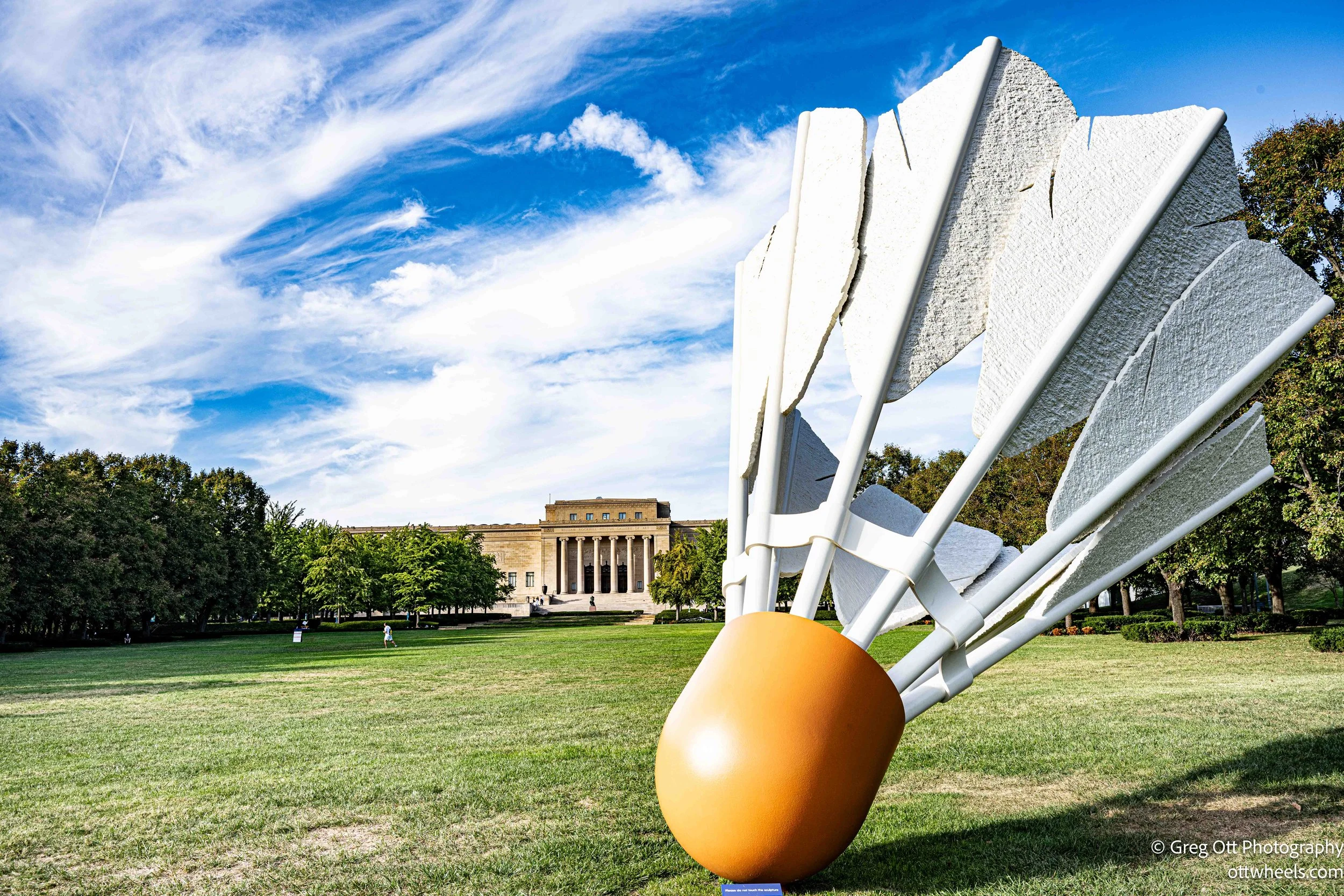Nelson-Atkins Art Museum
I arrived at the grounds of the Nelson-Atkins Museum of Art on a light, overcast morning, ready to stretch my legs among sculptures and modern architecture. The museum’s outdoor space, the Donald J. Hall Sculpture Park, is beautifully laid out, with Henry Moore pieces scattered thoughtfully across the lawns and tucked beneath tree lines. Moore himself visited the grounds in 1975 and contributed to the collection, so his work here feels especially rooted in place—less like a transplant and more like it belongs to the land.
One sculpture that immediately caught my eye was Ferment a stainless steel tree. Its branches reached upward, catching the gray sky and reflecting light in fractured, silvery shards. I walked around it several times, photographing from different angles, trying to capture how the light played across its open form. In the same garden, I spotted Robert Morris’s Glass Labyrinth, a triangular maze of glass walls meant to invite slow, meditative walking. Unfortunately, it was closed during my visit, but I could imagine how it must feel to wander in, only to retrace your steps back out—a simple, reflective journey through space.
Nearby stood the giant Shuttlecock, the playful public art installation by Claes Oldenburg and Coosje van Bruggen. Seeing a badminton birdie blown up to absurd proportions, perched lightly on the lawn, made me smile. It was whimsical, humorous, and completely at home against the museum’s classical façade.
Lunch at Rozzelle Court
Around lunchtime, I headed inside and found the museum café, Rozzelle Court. Stepping through its doors felt like leaving Kansas City and entering a courtyard in Florence or Buenos Aires. Ionic and Doric columns framed a balcony running around the upper level, while a fountain bubbled gently at the center. The space was lively but calm—people talking in low voices, others simply pausing between galleries.
I ordered a chicken salad croissant, a rich slice of key lime pie, and a cappuccino. Sitting there, I let the architecture soak in, enjoying how the museum had created a space that felt as much about atmosphere as food.
Modern & Contemporary Galleries
After lunch, I headed to the lower galleries where the modern and contemporary collections are housed. I wandered past pieces by Jackson Pollock, Roy Lichtenstein, Andy Warhol, and other familiar names of mid-to-late 20th-century art.
One work stood out—El Anatsui’s Dusasa I. At first glance, it looked like a shimmering tapestry, but up close, I realized it was crafted entirely from flattened liquor bottle tops and held together with fine copper wire. The surface rippled like fabric, yet it was all metal—recycled, reimagined, transformed into something monumental. It had presence: a blend of craft, history, and raw materiality that filled the wall with both light and weight.
Andy Goldsworthy’s Walking Wall
Back outside, I explored further and came across Andy Goldsworthy’s Walking Wall. It’s rare to see one of his works in a permanent museum setting, since so much of his art is ephemeral. I’d previously seen his pieces in the East Wing of the National Gallery and the piece at Frank Lloyd Wright's House on Kentuck Knob's near Pittsburgh, Pa. The wall winds through the landscape, threading between trees, crossing a path, and eventually ending inside the museum itself. It feels like a secret passage—a line of stone that quietly insists on its own journey.
Photography Highlights
The museum also has a photography section, which pulled me in right away. One display featured the famous sequential photographs of a horse running, taken by Eadweard Muybridge in the 1870s. He set up a line of cameras with tripwires to capture each stage of the gallop, proving for the first time that a horse does, in fact, lift all four hooves off the ground mid-stride. It seems like a small detail now, but at the time it was a revelation—science and art working together to answer a question people had debated for years. Those experiments went on to inspire the concept of motion pictures. Standing there, looking at those grainy frames, I couldn’t help but think how much of our modern media traces back to this single experiment with light, motion, and time. There were many other interesting photos in this section.
Josef Albers
I was excited to see a piece by Josef Albers hanging here: Homage to the Square: Red Brass (1961). I first encountered his work back in the 1970s at the East Wing of the National Gallery, where I even attended a lecture during one of his exhibitions. The speaker explained how Albers studied the way our eyes perceive color, especially at the edges where two hues meet. What looks like a sharp boundary can start to shimmer or blend, creating illusions of depth and shifting tones. Seeing his work again after so many years reminded me how something so deceptively simple—nested squares of color—can still captivate and trick perception, turning a flat surface into a living optical experience.
Isamu Noguchi
In the special exhibits, I discovered Isamu Noguchi, a sculptor I had only known by name. The Nelson-Atkins holds one of the largest collections of his work outside New York and Japan, and seeing them gathered here was like walking into a different world of form and material.
His Fountain (1987) consists of two basalt stones—one concave, one convex. Water runs across their surfaces in a slow, meditative trickle. Nearby was Six-foot Energy Void, a massive granite block carved so that its power comes as much from the empty space as the mass itself.
Equally fascinating was Ends, built from nine pieces of black Swedish marble. The blocks form a cubic structure punctuated by random openings, which allow you to peer into the center. Inside, the walls are smooth and polished, a sharp contrast to the exterior. The effect is part puzzle, part monument—solid yet full of mystery, inviting you to look through and wonder.
Noguchi’s pieces reveal his mastery of stone and his ability to balance weight, space, and light. They are as much about what is absent as what is present.
Impressionist Gallery Highlights
After the bold colors and heavy forms of modern art and sculpture, the Impressionist galleries felt like a refuge. The rooms were quiet, softly lit, and filled with works by Monet, Renoir, Degas, and others. The walls were painted in neutral tones, and seating invited you to pause, linger, and let the art work on you slowly.
One Monet water-lilies piece stopped me in my tracks. I stood there for several minutes, watching the way his brushstrokes flickered into life, as though the surface of the painted pond was still rippling under light.
What I love about Impressionist painting is how it changes depending on your perspective. Up close, it’s a storm of brushstrokes—raw, almost chaotic marks of color. Step back, and those same strokes dissolve into form: trees, reflections, faces, entire landscapes. It’s the science of optics, light separation, and even pointillism at work, discoveries that artists of the time embraced. This is what has always drawn me to Impressionism. Every time I encounter these works, I’m reminded that pure color can become shape, and light itself can be transformed into subject.
Closing Moments
It was near closing time when I stepped out the back side of the museum. I had only seen a fraction of what the museum had to offer. I lingered on the stairs, watching people stroll across the grounds, and found myself wishing there were more museums of this caliber in the world. There, among the outdoor sculptures, was Rodin’s The Thinker. It instantly brought me back to the monumental Rodin exhibition at the National Gallery’s East Wing in 1981—a show that had left a lasting impression on me.
By the time I made it back to the van, it was close to 6 p.m. I still needed to drive east to set up for tomorrow’s bike ride. The road ahead was about two hours, with gas and food stops along the way. I was struggling to keep my eyes open and finally pulled into a spot where highway construction material was stored. Confident no one would be working at that hour, I closed my eyes for “a few minutes.” Ninety minutes later, I woke refreshed and grateful I’d stopped.
I finally reached the Katy Trail trailhead in Rocheport around 9 p.m. I made a quick snack, settled in, and was asleep soon after—ready for my ride tomorrow.





























